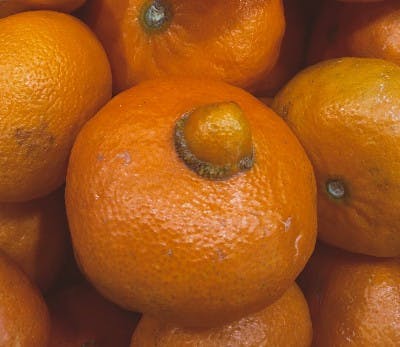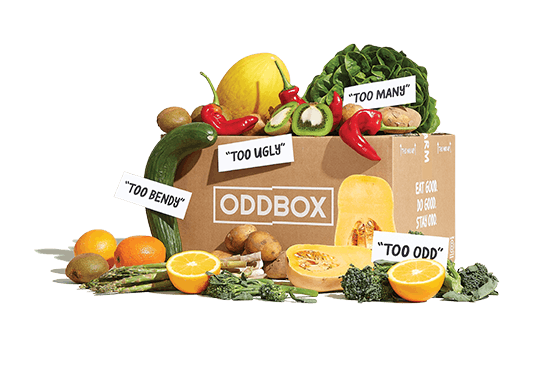It's Not All About Looks
If you rescue with us, you’ll know that fruit and veg doesn’t have to look pear-fect to taste peachy. Yet, it can be at risk of going to waste because it’s “too odd”. In reality, many of the marks and scars that make it “too odd” are often just surface-level and the inside is totally edible. But, unless you know your stuff, it’s not always obvious.

Want to brush up on the difference between odd-looking and fine-to-eat? Cosmetic defects can come in all shapes and sizes, but here’s a quick run-through of what we sometimes see.
Discolouration
Ever avoided an orange or a lemon because it looks a little green? While it might seem like a sign that it’s not ripe, it’s not. It’s just what happens when there isn’t enough of a contrast between how warm it is during the day and how cool it gets a night – the fruit inside will taste just the same.
Flowers
Yellow flowers on veg like broccoli might seem strange, but they’re nothing to worry about – just a sign that the broccoli was under a bit of stress when it was growing. It grows best in moderate weather, but if the soil gets too hot or too cold, flowers can form. They’re totally edible, just like every other part of the broccoli – stems and all.
Rusting
Unboxed some beans or leeks that look a bit rusty? Whichever veg you spot it on, rust is rarely anything to worry about, and it’s usually just on the outer parts – the veg inside should be totally fine. The rust should rinse away if you give the veg a quick wash before cooking (which we’d always recommend doing) but you can eat the rust if not, anyway.
Mechanical Damage
This might look like dents or scars and scratches, but it could also be chunks missing from the veg. Mechanical damage is usually caused by machinery used in the harvesting process to pick or clean the crops. It might leave veg looking a bit odd, but it doesn’t usually damage what’s inside.
Calcium Spots
Common on peppers and other soft-skinned veg, calcium spots tend to develop when soil doesn’t have enough calcium, or if a crop’s been over-watered after a period of drought. They might look a bit like rot, but they don’t get any bigger over time and can just be cut out – the rest of the pepper is perfectly edible.
Tip Burn
Most common on lettuces, this is when the very ends of the leaves turn brown or black. It might look like the lettuce has gone bad, but it can just be another sign of calcium deficiency, caused by drought, water-logging or just if the crop’s under stress. And sometimes it’s something else altogether – these marks can happen if the leaves rub against fleece coverings used to protect against frost.
Hail Damage
Hail can mark the skin of fruit and veg, leaving brownish dents on the surface. And while these don’t look the prettiest, the inside is usually pretty much untouched. Unfortunately, any fruit or veg that has these marks are likely to be “too odd” for the supermarket, but we know it’s what’s on the inside that counts. Check out this story about when we rescued nearly 500 tonnes of hail-marked apples at risk of going to waste in 2020.
Zippering
Scarring, or zippering, on tomatoes are brown lines on the skin. They happen when the anther (the part where the pollen’s made) of the tomato flower sticks to the skin of a growing tomato – as it grows, so does the scar. Sometimes they’ll open up, but they’ll usually heal – that’s what the brown scar is. The rest of the tomato is completely edible, you just might want to cut the scar out.
Protruding Navel
Sometimes seen on satsumas (especially in Mandarin Queen Satsumas), these lumps and bumps on the outside might look a bit odd but they’re totally safe to eat. They’re caused by double flowering on the plant, and often have another tiny fruit inside, which is slightly sweeter than the main one.
Light Leaf Spot
You might see these grey spots on brassicas, like Brussels sprouts. They look a little bit like inky thumbprints, but they’re actually caused by spores in the air and they’re most common in crops that grow in Northern England and Scotland. The marks are usually just on the outer leaves that you might compost when cooking, but they’re fine to eat if you wanted to.
Latex Oxidisation
These black marks (most commonly seen on sweet potatoes) might look like ink or tar, but they’re actually the natural sugars and latex coming out of the ends. This usually happens when they’re freshly trimmed after harvest and is white at first, but then turns black and hardens when it makes contact with the air (oxidises).
Knowing the difference between surface-level marks and signs that something’s not fresh can help save perfectly edible food from waste. Feel free to reach out to our Customer Happiness team if you’re unsure about marks on fruit or veg you get in your box– they’re here to help!

